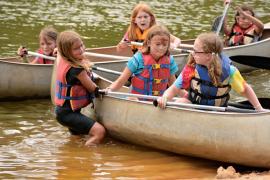Nonprofit organizations are nothing if not complex — and nonprofit camps are no exception. While each nonprofit is unique, one thing they all have in common is a board of directors. For some of you, this governing body may feel like a distant, disengaged entity. While for others, this group may seem highly engaged and invested in your organization and its future. Regardless of your perception or experience, your camp’s board of directors plays a critical role in the life of your nonprofit. It might also offer you an opportunity for personal and professional growth — and a way you can further serve your camp or another nonprofit organization.
Whether you wish to serve as a board member or just learn how best to work with your nonprofit’s board, you need to understand its functions, roles, and responsibilities.
Picture your camp as an old-fashioned train. The board of directors is the conductor. Your staff and volunteers make up the train crew. And your campers, families, and donors are along for the ride as the train’s passengers. Ready to go? All aboard!
Train Conductors
Let’s take a closer look at who’s guiding your train. What is a board of directors? Who are they? What do they do?
According to Herrington J. Bryce of Nonprofit Quarterly, “A board is needed to incorporate a nonprofit, to get it tax exemption, to apply for a bank account, to properly file annual reports, and to do most important transactions” (2017). Essentially, your board serves to make sure your organization is legally operable.
While you may think of the board as one, singular unit, ideally your board of directors will include a variety of personalities, backgrounds, and strengths. For camps, this often includes — but is not limited to — individuals who are highly knowledgeable and experienced in the summer camp industry; who seek leadership opportunities; who both understand and contribute to the organization’s finances; and who know, recognize, and appreciate the organization’s culture.
Beyond the legal jargon, what exactly do board members do?
On our nonprofit train, the conductors look at the whole train and, based on their expertise, serve as advisors on how the train should run. They help the crew feel comfortable, supported, and encouraged. They work with the crew to identify problems. They oversee the train’s budgets and finances. And, with the help of the crew, they look to the horizon and think strategically about where the train will travel today, tomorrow, and ten years from now.
What’s the Difference between a Board Chair and Board Members?
While each member on the board holds a leadership position, your board chair serves as the board’s leader — or head conductor. Another way to look at it is that if your board members are campers, your board chair might be their counselor.
A board chair presides over meetings, serves as a spokesperson for the organization, upholds the institution’s culture and values, and works closely with the executive director, CEO, or camp director(s). Together with the camp leaders and staff, a board chair makes sure the camp’s goals are aligned with its mission and on the right track (McKinney, 2021).
What about the Board Members?
As we’ve learned, your board members (ideally) include a variety of individuals who bring a number of skills and experiences to the table. The National Council of Nonprofits defines board members as “the fiduciaries who steer the organization toward a sustainable future by adopting sound, ethical, and legal governance and financial management policies, as well as by making sure the nonprofit has adequate resources to advance its mission” (2022). Fundamentally, your board members are people who are highly invested in your organization — both in terms of time and resources — and who are willing to work collaboratively to help it succeed.
Your board members are willing and ready to contribute to the conversation. They know what value they can provide, and they utilize their networks, resources, and abilities in doing so. Board members are often assigned to committees to achieve certain initiatives, such as fundraising, social events, or capital campaigns. If committees are the train cars, then board members serve as the conductors of each, making sure that the wheels are well-oiled and that they’re following in line with the locomotive.
|
The National Council of Nonprofits lists three basic duties that a board of directors should follow: Duty of Care Duty of Loyalty Duty of Obedience |
Beyond the board chair, several board members may hold leadership/officer positions to make sure meetings are timely, effective, and that the board is moving toward and accomplishing its initiatives. According to Leigh McKinney of MissionBox, these positions include but are not limited to (2021):
- Vice chair — works closely with and fills in for the board chair if necessary
- Secretary — attends all meetings and keeps minutes (or notes) while also keeping a close eye on the organization’s bylaws
- Treasurer — keeps track of the organization’s financial condition and reviews annual audits
Committees
“The board of directors accomplishes much of its work through committees, which undertake work delegated by the board, make recommendations to the board for discussion and action, and enhance board productivity,” says McKinney (2021).
Common standing committees include:
- Governance committee. Also known as the nominating committee, this group recruits and orients new board members and develops ongoing educational opportunities for the entire board.
- Finance and/or audit and risk committee. This group reviews the organization’s audit firm, reviews the auditor’s reports, and makes the board aware of key risks the nonprofit faces — and strategies for dealing with those risks.
- Executive committee. This group creates the agenda for full board meetings and is empowered to deal with issues that arise between meetings. Membership of this committee is typically limited to board officers and the executive director or chief executive.
Examples of other committees, McKinney writes, include fundraising, investment, personnel, compensation, marketing, communications, and programs. There are many opportunities, but it’s important for a board to consider its time, expertise, bandwidth, and responsibilities when developing committees (McKinney, 2021).
Your organization’s own train may have a similar structure or something very different. At the end of the day, however, board members care deeply about their organization and are ready to listen, to learn, and to serve.
Ready for Board Service?Let’s look at steps to take to see if joining a board of directors is right for you. Consider your passion and expertise. Know what you’re getting into. Don’t hold back. |
If an opportunity arises to join a board of directors, make sure that it’s the right fit for you — and vice versa. Doing your homework will save you both time and energy and can give you insight into what skills you may need to develop or experiences you want to have. If it’s a match, great! If not, don’t be discouraged; other trains will come down the track if you keep your eyes peeled. There are plenty of ways you can serve the organization — ask about volunteer opportunities or other areas of involvement. Maybe you can help raise funds, plan events, or work with volunteers on project development. The love you have for camp is incredibly valuable, and expressing your passion through service is beneficial for all.
Working Well with Your Board of Directors
No matter where you sit on the nonprofit train, it’s important to remember that you are an integral part of the whole and should strive to work well with others. As much as possible, try to avoid a sharp divide between the board of directors and the rest of your organization. Urge board members to be supportive and to engage with and encourage staff and volunteers. Seek to establish a culture that welcomes conversation, in which people can safely ask questions, share ideas, and express opinions (Shekshnia & Zagieva, 2017). Coming together, listening to one another, and being open-minded can create a harmonious environment between your organization and its board of directors.
When we work together, we make sure the train is on the right track, riding confidently into the future. All aboard!
Additional Questions to Ponder
- How well do you know your board of directors? What are ways you can connect with them? Maybe share a meal, work on a project, or invite them to sit around a campfire. Cultivating relationships between your board, staff, and volunteers can not only keep board members informed of what’s going on at camp, but can also provide insight into what board membership looks like.
- What can you contribute to a board of directors? Think about areas in which you are exceptionally skilled. Do you love marketing and public relations? Are you a great fundraiser? Don’t be afraid to admit your strengths. They just might be what your board is looking for.
- What skills do you want to develop? If you’re considering board membership, what are areas in which you can grow? Talk with board members about qualities and experiences that make an effective board member. Look for leadership opportunities, learn more about financial strategies, or think about what improvements or changes you’d like to see to help support the camp’s mission.
References
BoardSource. (2018, April 16). Be an Exceptional Board Member. boardsource.org/fundamental-topics-of-nonprofit-board-service/composition-recruitment/board-service/exceptional-board-member/
National Council of Nonprofits. (2021, December 23). Board Roles and Responsibilities. councilofnonprofits.org/tools-resources/board-roles-and-responsibilities
Bryce, H. J. (2017, August 21). Nonprofit board responsibilities: The basics. Nonprofit Quarterly. nonprofitquarterly.org/nonprofit-board-governance-responsibilities-basic-guide/
McKinney, L. (2021, March 17). Board officers and committees: What structure works best? MissionBox Global Network. missionbox.com/article/68/board-officers-and-committees-what-structure-works-best
Shekshnia, S. & Zagieva, V. (2017, August 24). The 3 Es of Effective Board Leadership. INSEAD Knowledge. knowledge.insead.edu/leadership-organisations/the-3-es-of-effective-board-leadership-6961
Lauren McMillin is the American Camp Association’s public relations and communications manager.





